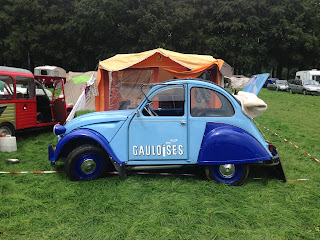We’re back in familiar territory this month. But for a good reason, I hope you’ll agree. If you don’t know, 2018 is the 70th anniversary of the 2CV. Yes, it was in 1948 when Citroen unveiled a car that is as French as a ham and cheese baguette. And just as simple. Let’s have a recap on why these little cars are so important.
I’m sure most are familiar with the unalloyed minimalism of the 2CV. Depending on your point of view this is its abiding appeal. Or the source of much mirth for those who like a little more content in their classics.
Of course, their many owners love them dearly. But for those who still laugh it’s worth knowing what early reviewers said about the ‘deuche’.
Autocar applauded "the extraordinary ingenuity of this design, which is undoubtedly the most original since the Model T Ford". The Globe and Mail called it a "car like no other". When you’re familiar with the stripped-down nature of this car, you’ll know that ‘stark’ is an apt descriptor. But, it does somewhat hide the remarkable engineering underpinning what is essentially a cheap peasants’ car.
Ruthlessly simple and utterly logical, it is a vehicle stripped to the very quick. The motoring writer L. J. K. Setright described the 2CV as "the most intelligent application of minimalism ever to succeed as a car’. He further praised its. "remorseless rationality."
When Citroen specified the car, they had a pure USP in mind. They wanted to mobilise the French rural populous. To move them from agricultural vehicles which still included the horse and cart. As such, it needed to be cheap to buy, easy to maintain and highly adaptable.
People familiar with the 2CV know at least some of the fundamental design concepts. That one should be able to wear one’s best Sunday hat while driving. Perhaps, as they transport a basket of unbroken eggs across a ploughed field.
Citroen designed adaptability into the car. You can remove the roof, back window, boot lid and rear seats? Doing this creates what is essentially a pick-up truck. A French farmer could use his 2CV to take cases of wine, bales of hay or livestock to the local market.
In the modern age, a deuche makes a modest trip to IKEA very doable!
The original car, launched in 1948, had a 375cc two-cylinder, air-cooled engine. The design was inspired by a BMW motorcycle boxer engine. With 9 bhp and 40 mph top speed it wasn’t going to win any races. But speed wasn’t the point. Function trumped all. And even if the languid pace leaves us unimpressed today, it was still faster than a tumbril.
The point here is to know that the engine’s designer Walter Becchia was working to a strict brief. Simplicity was foremost. And keeping within the strict French CV taxation rules to keep the car affordable. The engine was updated to a 12 bhp 425cc in 1955. By the end of its production run in 1990, it had a 602cc/28bhp engine capable of 65-70 mph. Still hardly a ball of fire.
Sadly, this perceived lack of horsepower distracts from the innovation Becchia built into his elegant engine. Look closely. There are no pumps, hoses, or complicated electrics to go wrong and there are no belts to wear and snap. All essential services including ignition, cooling and electrics feed of the main drive shaft. As long as the car is running, it’s likely to continue to do so.
So robust is this simple engine that in bench tests it was run at full throttle for 1000 hours. The equivalent of 50,000 km of continuous driving without issue.
Putting all that together what most find surprising is that when used as a basic run-around the 2CV is highly adept. In the low range, it is surprisingly quick. When driven with some brio on suburban roads you’ll struggle to shake it off in any car. A deuche can take corners at terrifying speeds. Its alarming body roll and long-travel suspension ably kill off speed limiting understeer.
Let’s also not forget that the 2CV platform gave us a huge variety of interesting cars. All based on its humble engineering. The Dyane, Mehari, Fourgonette Vans, The Visa and the very rare Bijou all owe their existence to Citroen's desire to mobilise France. That’s a real legacy if ever there was one.
With a 2CV and its stablemates, what you get is the distilled essence of a car. Everything you need is there and barely a gramme more. Perhaps best of all is that a 2CV now elicits grins from bystanders. They have transcended the perception of being a hippy car to become a classless, desirable runaround. And it only took 70 years for it to happen!
So there you have it. You might still have your reservations, and none would blame you. But as a coda to my little homage, our aim is to celebrate the 70th anniversary at this year’s Woodsmoor Classic Car Show. We’re going to have a motivating display of the 2CV and its variants.
You’ll get to see up close why so many have an enduring affection for this minuscule French Fancy.
Hopefully see you there.
Hopefully see you there.






No comments:
Post a Comment